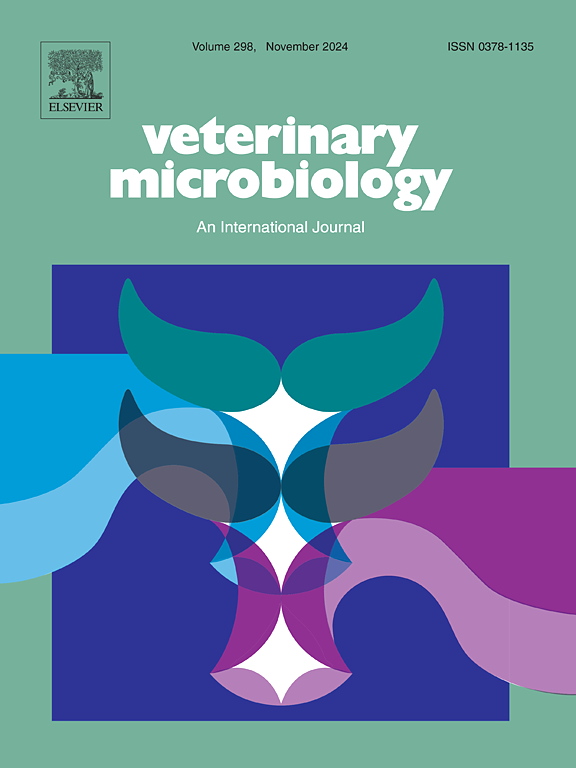粪便涂片、粪便PCR和血清ELISA检测禽分枝杆菌亚种诊断准确性的贝叶斯估计。沙特阿拉伯四种家养反刍动物的副结核感染。
IF 2.7
2区 农林科学
Q3 MICROBIOLOGY
引用次数: 0
摘要
副结核是一种影响全世界家畜和野生反刍动物的慢性消耗性疾病,由鸟分枝杆菌亚种引起。副结核(地图)。现有各种检测MAP感染的诊断测试;然而,它们没有一个具有完美的准确性,不能作为合格的参考标准测试,特别是由于它们明显的低灵敏度。因此,我们使用贝叶斯潜类模型(BLCMs)来估计粪便涂片(FS)、粪便PCR和血清ELISA检测沙特阿拉伯2岁以上绵羊、山羊、牛和骆驼MAP感染的诊断准确性。在沙特阿拉伯东部省对31个有MAP感染史的不同农场进行的横断面研究数据进行了分析。每个农场收集了所有2岁以上动物的粪便和血液样本,总共采集了220只绵羊、123只山羊、66头牛和240只骆驼。用FS和IS900-PCR分别检测抗酸杆菌和MAP DNA。采用IDEXX ELISA试剂盒检测血清样品中的MAP抗体。对于每个反刍动物种群,拟合BLCM以获得三个测试的灵敏度(Se)和特异性(Sp)的后验估计[中位数和95 %贝叶斯可信区间(95 % BCI)]。我们假设FS和PCR有条件地依赖于动物的真实MAP状态。如果可用,则使用测试精度的先验分布。在所有试验和所有物种中,FS的硒含量最高,绵羊、山羊和骆驼的硒含量中位数约为80 %,牛的硒含量中位数约为50 %。ELISA和PCR的中位Sp值均高于90% %。FS在骆驼、绵羊和山羊身上的Sp值最低。根据本研究中观察到的患病率,PCR和ELISA的中位阳性预测值(PPV)高于骆驼、绵羊和山羊的FS。在牛中,所有测试的PPV都相似,中位数估计值为> 95 %。在骆驼、绵羊和山羊中,所有试验的中位阴性预测值(NPV)为> 60 %。在所有试验中,牛的净现值中值最低(本文章由计算机程序翻译,如有差异,请以英文原文为准。
Bayesian estimation of diagnostic accuracy of fecal smears, fecal PCR and serum ELISA for detecting Mycobacterium avium subsp. paratuberculosis infections in four domestic ruminant species in Saudi Arabia
Paratuberculosis, a chronic wasting disease affecting domestic and wild ruminants worldwide, is caused by Mycobacterium avium subsp. paratuberculosis (MAP). Various diagnostic tests exist for detecting MAP infection; however, none of them possess perfect accuracy to be qualified as a reference standard test, particularly due to their notably low sensitivity. Therefore, we used Bayesian latent class models (BLCMs) to estimate diagnostic accuracy of fecal smears (FS), fecal PCR and serum ELISA for detecting MAP infections in sheep, goats, cattle, and camels older than 2 years in Saudi Arabia. Data from a cross-sectional study conducted in the Eastern Province of Saudi Arabia on 31 different farms with a history of MAP infection were analyzed. Fecal and blood samples from all animals older than 2 years in each farm were collected, resulting in a total of 220 sheep, 123 goats, 66 cattle, and 240 camels sampled. FS and IS900-PCR were performed on fecal samples to detect acid-fast bacilli and MAP DNA, respectively. The IDEXX ELISA kit was used to detect MAP antibodies in serum samples. For each ruminant species population, a BLCM was fitted to obtain posterior estimates [medians and 95 % Bayesian credible intervals (95 % BCI)] for sensitivity (Se) and specificity (Sp) of the three tests. We assumed FS and PCR to be conditionally dependent on the true animal MAP status. Prior distributions for test accuracy were used if available. FS had the highest Se among all tests and across all species with median values around 80 % in sheep, goats and camels, and near 50 % in cattle. Median Sp estimates of ELISA and PCR were higher than 90 % for all species. FS yielded the lowest Sp of the study when applied in camels, sheep, and goats. Using the prevalence observed in this study, median positive predictive value (PPV) was higher for PCR and ELISA than FS for camels, sheep, and goats. In cattle, PPV of all tests was similar with median estimates > 95 %. In camels, sheep, and goats, median negative predicative value (NPV) of all tests were > 60 %. The lowest median NPV for all tests were observed in cattle (< 30 %). Our results suggest that ELISA is a suitable option to identify MAP infected animals in farms with previous history of MAP in the Eastern region of Saudi Arabia.
求助全文
通过发布文献求助,成功后即可免费获取论文全文。
去求助
来源期刊

Veterinary microbiology
农林科学-兽医学
CiteScore
5.90
自引率
6.10%
发文量
221
审稿时长
52 days
期刊介绍:
Veterinary Microbiology is concerned with microbial (bacterial, fungal, viral) diseases of domesticated vertebrate animals (livestock, companion animals, fur-bearing animals, game, poultry, fish) that supply food, other useful products or companionship. In addition, Microbial diseases of wild animals living in captivity, or as members of the feral fauna will also be considered if the infections are of interest because of their interrelation with humans (zoonoses) and/or domestic animals. Studies of antimicrobial resistance are also included, provided that the results represent a substantial advance in knowledge. Authors are strongly encouraged to read - prior to submission - the Editorials (''Scope or cope'' and ''Scope or cope II'') published previously in the journal. The Editors reserve the right to suggest submission to another journal for those papers which they feel would be more appropriate for consideration by that journal.
Original research papers of high quality and novelty on aspects of control, host response, molecular biology, pathogenesis, prevention, and treatment of microbial diseases of animals are published. Papers dealing primarily with immunology, epidemiology, molecular biology and antiviral or microbial agents will only be considered if they demonstrate a clear impact on a disease. Papers focusing solely on diagnostic techniques (such as another PCR protocol or ELISA) will not be published - focus should be on a microorganism and not on a particular technique. Papers only reporting microbial sequences, transcriptomics data, or proteomics data will not be considered unless the results represent a substantial advance in knowledge.
Drug trial papers will be considered if they have general application or significance. Papers on the identification of microorganisms will also be considered, but detailed taxonomic studies do not fall within the scope of the journal. Case reports will not be published, unless they have general application or contain novel aspects. Papers of geographically limited interest, which repeat what had been established elsewhere will not be considered. The readership of the journal is global.
 求助内容:
求助内容: 应助结果提醒方式:
应助结果提醒方式:


